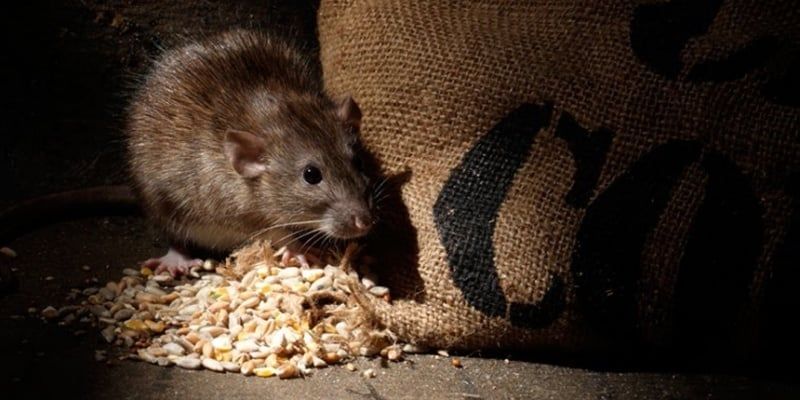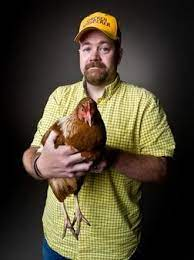Rodent Control: In and around the coop


One of the biggest complaints made by opponents of chicken keeping is that chickens attract rodents. While chickens themselves do not attract rodents, certain activities associated with keeping chickens have the potential to attract rodents. Still, that does not mean that rodents are an inevitability in and around the coop. It is up to the flock owner to make certain that the way you keep your chickens does not attract rodents. And if you already have a rodent problem, we will discuss solutions for you. Rodents that tend to be seen around the chicken coop include the house mouse (Mus musculus), the Norway rat (Rattus norvegicus), and the roof rat (Rattus rattus). Rodents are successful as a species because they are able to adapt and change to take advantage of the resources in different environments. That does not mean, however, that they are without limits. It is those limits that you will take advantage of in order to keep them out of your coop.
Biosecurity
Rodents are vectors of disease for more than just humans—they can bring disease to your flock. Rodents will ruin your biosecurity plan because they carry disease organisms that can contaminate your eggs externally, as well as infect your chickens, thereby potentially contaminating your eggs internally. Rodents are both mechanical and biological vectors. A mechanical vector means that they carry disease organisms on the outside of their bodies, particularly on their feet and fur. As they move around the coop, they can deposit organisms onto surfaces such as eggs or water. A biological vector means that they carry disease organisms on the inside of their bodies, shedding them in their feces. Rodents are very intelligent. They watch, listen, and learn as you move about your daily routine. Rodents can become bold as you make management mistakes. Human error is easily correctable, though, and you can stick it to them by changing your behavior.
Food and shelter
Rodents are mainly attracted to two things: food and shelter. Rodents are not picky eaters, which is why they are so successful as a species. They will consume eggs, chicks, and chicken feed. Rats will consume all three sources of food while mice will usually take advantage of just the chicken feed.
- Food
So how do you keep rodents from taking advantage of feed sources? For eggs, all you need to do is collect all of your eggs, twice a day. The longer an egg sits in the coop, the greater the likelihood that an animal may find the egg and attempt to consume it. If you have already seen rodents in the coop, then you will want to wash your eggs. For chicks, you will want to brood them in a rodent-proof coop. Count your chicks daily, and if any are missing, figure out where a predator—such as a rat—could have entered. If you are putting an old coop back into service, rodent-proof the coop before starting chicks in case a rodent is still in residence. Chicks should be large enough to safely place them out in the coop once they get to about six weeks old—with the exception of some bantam breeds. As for the chicken feed, there are a couple of options. First of all, store your extra chicken feed bags in a metal trash can with a tight-fitting lid. Why metal? It takes rodents much longer to chew through the base of a metal trach can, whereas plastic can be breached in a matter of minutes. Rodents can chew through metal, and even cinder block, although they would rather seek food from an easier source. Check the base of your feed storage can weekly to see if there are any holes. Most metal or plastic chicken feeders are designed to be hung as another deterrent to rodents. However, rodents are good jumpers and have even been known to climb down chains that are used to hang feeders. Your best option is to store feeders in a small metal trash can at night. Chickens do not eat after lights-out anyhow. To prevent rodents from having access to feed that the chickens have thrown on the floor during the day, place your feeder over a fine wire mesh stand with a collection tray below. Simply empty the tray back into the feeder twice daily to reduce waste. - Water
Water is just as important as food for a rodent. If you use a closed water system, such as a nipple drinker, then rodents will look for other sources of water. You can use this to your advantage. As the desperation for water increases, you can place rodent bait or traps near a water source that you provide outside the coop (to make sure your chickens will not be harmed by them). You should not have a great deal of standing water around in your yard or coop. It promotes mosquito breeding, which brings with it all kinds of other problems for you and your birds. Standing water can also be utilized by rodents that you would rather not have nearby. - Shelter
Shelter for rodents is a safe place for them to sleep and night and also where they can raise young. Life for rodents revolves around the burrow. Rodents do not like change, and when you move things around, they get nervous. Eliminate rodent housing by seeking out burrows and rodent highways. Burrows are different from highways into and out of your coop. If you are not sure if a burrow is active, then take a piece of newspaper and lightly wad it up, placing it in the burrow entrance in the evening. If it is moved in the morning,then somebody is home. Certain rodents do not like disruption to their territory so they will seek a home elsewhere if you remove their access to shelter. Mice tend to stay within a 25-foot radius of the burrow and have good visual acuity only 6 inches in front of them. However, they can detect movement further away, it is just blurry. Rats have a larger territory. They tend to stay within a 100-foot radius of the burrow and are very fearful of new objects in their territory. If you smell rodent urine, then start looking for their highways Not sure if you have rodents? Then shake a thin layer of white flour on the feed room floor and see if there are tracks in the morning. The flour may also help you identify rodent highways. Rodents like to stick to certain covered or secluded routes on their way to and from food, water and the burrow. Rodents tend to travel along the edges of buildings or under cover, rather than travel out into the open where a predator may spot them. Rodent travel routes are often covered with feces, because rodents defecate as they move. One rodent dropping can contain thousands of [I]Salmonella[I] bacteria. Another way to identify rat highways is to look for rub marks along walls, because the oils from rodent fur will darken wood where they travel or where they must squeeze through openings. Rats are amazingly agile and can maneuver up walls or around ceiling beams so be sure to check overhead as well as below. Mice can squeeze through holes as small as 1/4 of an inch and rats can squeeze through holes as small as 1/2 an inch. Be critical of any space or gaps in the coop prior to your purchase. If you are repurposing an old building, you may need to make extensive repairs, not to keep the chickens in, but to keep rodents out.
Prevention
Clean up feed spills immediately in your feed room or in the coop to deny rodents a food source. Keep the grass mowed short around the edges of the coop and in your yard. This is an intimidating barrier for a rodent as they do not want to be spotted by a predator should they cross an open space. Place a three-foot wide strip of gravel around the edge of your coop to create yet another barrier to the building. Remove junk piles to deny shelter to rodents. During weekly cleaning checks, look for new holes and move objects to look for nests or feces. Rodents breed quickly so be vigilant.
Rodent removal
For rodent removal you have a couple of options: traps and baits. There are positives and negatives with each, so your best option is to use prevention as your first line of defense.
- Traps
Traps can consist of live traps, snap traps, or electronic traps. Live traps are an option if you do not like the thought of killing rodents. Keep in mind that captured and released mice have been known to travel several miles (even crossing creeks) to return to their home. Take them for a nice, long ride before releasing them. Some product names to ask for are Ketch-All, Mouse Master, Tin Cat, and Kwik-Katch. - Snap traps are the most common and affordable option for flock owners as they can be purchased at many types of stores. Keep in mind that rats are fearful of new objects in their territory. That means it will be a several days to a couple of weeks before a rat comes anywhere near a trap you set out. Leave the rat trap baited and unset for the first couple of weeks to get the rats used to it as a food source before you set the trap for the first time. You are trying to avoid situations in which the rodents become trap-shy. Mice, on the other hand, show no fear of new objects and you can set the traps right away.
- Make the battle decisive, and in your favor, by setting several traps in one night. If you see one mouse, then do not hesitate to set 5 to 10 traps. Just place them in in the highways and around food sources in the feed room or wherever the rodent was seen.Avoid setting traps where your chickens are likely to come into contact with them. If feed mills and feed stores hire professionals to keep rodents at bay where your grain and feed are processed, then it is your duty to keep that feed free of rodents until the chickens eat it.
- Electronic traps by Victor are becoming hard to find in the stores, but you can still purchase them online. They are very easy to use—all you need are 4 AA batteries to operate the trap. The rodent goes into the trap to find the bait and is zapped. The flashing light on top of the trap indicates a rodent has been dispatched. You do not need to touch the mouse to discard it.
- Baits
Rodent baits are a way to deal with rodents who are trap-shy or to manage rodents for the long term if your location is infested regularly. Rodent bait comes in many different forms from pellets to bait blocks. Keep in mind that baits fall into two categories: quick kill and anticoagulants. Always read and follow label directions when using a bait. Baits are not a set it and forget it method of rodent control. You do need to monitor the bait weekly, or more frequently in the beginning to see if it is working. Replace bait as needed and rotate three times a year between a quick kill and anticoagulant bait.
Keep baits in bait boxes or in a homemade PVC bait station which is very easy to make —a quick Google search can show you how. This will keep your chickens, pets, and any other non-target animal species from gaining access to the bait.
You love your chickens and want them to be happy and healthy. A wise chicken owner does all that they can to manage their flock well. The chickens have no choice but to live with rodents and their feces if you choose to do nothing. Hopefully, you now understand what you are looking for when looking to prevent a rodent problem. Happy hunting!
Tags:Plain Talk

Chicken Whisperer is part of the Catalyst Communications Network publication family.












